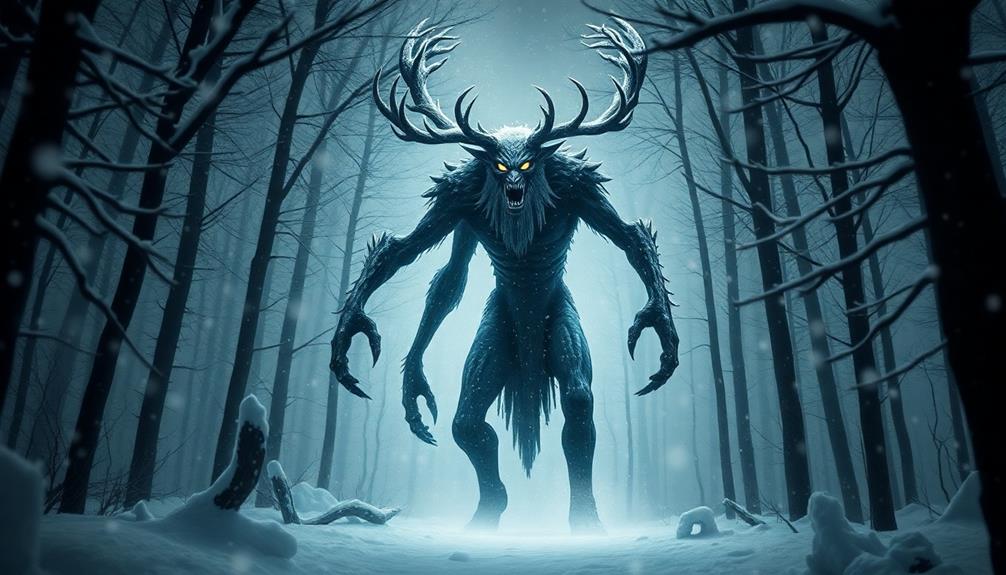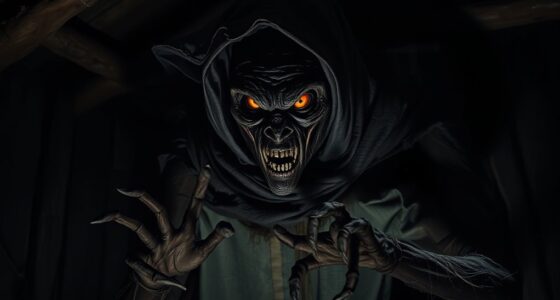The Tokoloshe is a mischievous, often invisible spirit from South African folklore that can cause trouble or fear. It represents deep-rooted cultural beliefs, embodying community fears and moral lessons. People use rituals and charms for protection against this spirit, especially at night. The legend highlights the importance of respecting traditions and spiritual practices. If you want to learn how the Tokoloshe influences daily lives and community values, there’s more to explore below.
Key Takeaways
- The Tokoloshe is a small, hairy, invisible creature from South African folklore, often associated with mischief and malevolence.
- It is traditionally invoked for protection or revenge, embodying community fears and moral lessons.
- Rituals and charms are used to ward off the Tokoloshe, especially during vulnerable nighttime hours.
- The legend highlights the importance of respecting cultural customs and spiritual practices within communities.
- As a cultural symbol, the Tokoloshe reflects societal values, fears, and the enduring influence of indigenous beliefs.

Have you ever heard of the tokoloshe, a mischievous and sometimes malevolent spirit deeply rooted in South African folklore? This creature is more than just a myth; it’s woven into the fabric of traditional beliefs that have been passed down through generations. In many communities, the tokoloshe is believed to be a small, hairy creature capable of becoming invisible at will, often summoned or invoked by those seeking revenge or protection. Its presence is thought to be a powerful reminder of the spiritual world’s influence on everyday life, making it a significant figure in the cultural landscape of South Africa.
The cultural significance of the tokoloshe extends beyond mere superstition. It embodies fears, moral lessons, and societal norms that have persisted for centuries. Traditional beliefs hold that the tokoloshe can be called upon by using specific rituals or charms, especially when someone feels vulnerable or threatened. For many, it’s a way of explaining unexplained misfortunes or illnesses, serving as a spiritual scapegoat for life’s hardships. In rural areas, stories about encounters with the tokoloshe are shared as cautionary tales, emphasizing the importance of respecting elders, honoring spiritual practices, and maintaining social harmony. These stories reinforce community values and serve as a means of cultural transmission, ensuring that the legend remains relevant and alive.
You might also find that the tokoloshe’s cultural significance is reflected in local ceremonies and protective practices. Some communities wear talismans or perform rituals to keep the spirit at bay, especially at night when the tokoloshe is believed to be most active. These practices aren’t just superstitions—they’re a way of connecting with traditional beliefs that emphasize spiritual protection and communal well-being. The tokoloshe, thus, acts as both a cautionary figure and a symbol of the unseen forces that influence daily life. Its presence underscores the importance of spiritual awareness, respect for cultural customs, and the ongoing relevance of indigenous beliefs in contemporary South Africa. Additionally, the tokoloshe often represents a cultural symbol embodying community fears and moral lessons passed down through generations.
Ultimately, understanding the tokoloshe’s role in South African culture reveals how traditional beliefs shape social behavior and worldviews. It’s a reminder that folklore isn’t just entertainment—it’s a reflection of history, morality, and the collective psyche of a community. Whether feared or revered, the tokoloshe remains an enduring symbol of South Africa’s rich cultural tapestry, illustrating how stories and spirits continue to influence lives long after they are told.
Frequently Asked Questions
Are There Modern Sightings of the Tokoloshe Today?
Yes, there are modern sightings of the Tokoloshe today, mostly as urban legends shared in communities and online. You might hear stories from locals claiming they’ve seen or felt its presence, especially at night or in remote areas. These modern sightings keep the myth alive, blending traditional beliefs with contemporary fears. Despite lacking concrete evidence, the Tokoloshe remains a fascinating part of South African folklore that continues to intrigue and scare people.
How Do Locals Protect Themselves From the Tokoloshe?
You can protect yourself from the tokoloshe by using protective charms, as folklore beliefs suggest. Many locals place objects like salt, amulets, or even sit with their head covered to ward off this mischievous spirit. Think of these rituals as shields, guarding you from harm. While the stories are rooted in tradition, they serve as a reminder of cultural beliefs that keep the legend alive and your fears at bay.
Is the Tokoloshe Linked to Any Specific Cultural Rituals?
The Tokoloshe is linked to traditional rituals where locals seek spiritual protection. You might participate in ceremonies or perform specific rituals, like placing charms or amulets under your pillow, to ward off its mischievous influence. These cultural practices are believed to invoke protective spirits or ancestors, ensuring your safety. Engaging in these traditional rituals helps maintain spiritual balance and keeps the Tokoloshe at bay, according to local beliefs.
Can the Tokoloshe Be Summoned or Controlled?
You can’t truly summon or control the Tokoloshe, as it’s believed to be a mischievous spirit beyond human manipulation. Instead, people use spiritual manipulation and ritual prevention to keep it at bay. These practices involve charms, prayers, or traditional rituals that protect against its influence. Attempting to directly summon or control the Tokoloshe isn’t advisable, as it’s thought to be unpredictable and best kept away through respectful spiritual precautions.
What Are the Origins of the Tokoloshe Legend?
The legend of the tokoloshe has mythical origins rooted in South African folklore development. You’ll find that it likely started as a way to explain strange or frightening events, blending traditional beliefs and cultural stories. Over time, these tales evolved, shaping a mythic figure that embodies mischievous spirits. The tokoloshe’s origins reflect the rich cultural history, serving as a symbol of supernatural forces in local narratives and societal fears.
Conclusion
As you explore the tokoloshe’s mysterious world, remember that over 60% of South Africans believe in its power, highlighting its deep cultural significance. This mischievous spirit isn’t just folklore—it’s woven into daily life and stories, reminding you of the rich traditions that shape South Africa. So next time you hear a strange noise or feel uneasy at night, consider the tokoloshe might be lurking nearby, mischievously watching.










